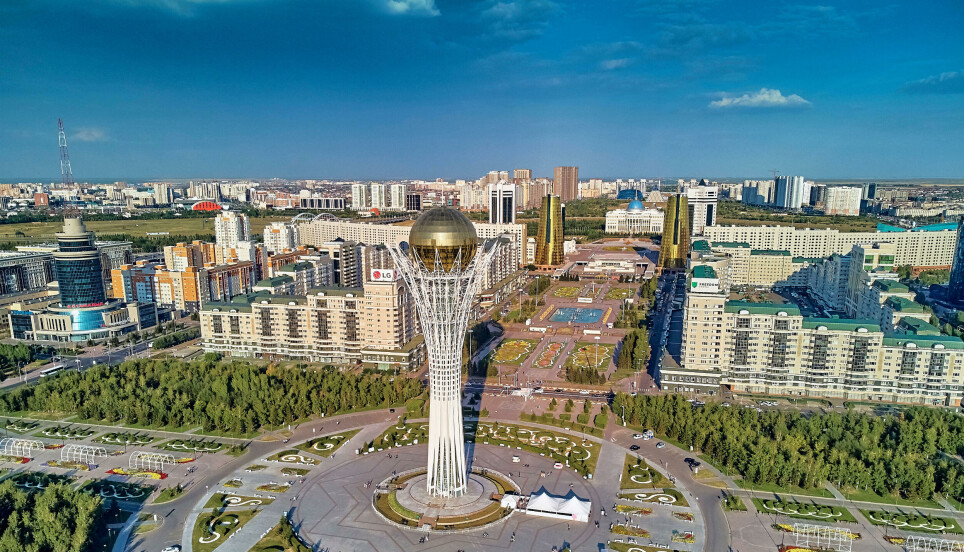THIS ARTICLE/PRESS RELEASE IS PAID FOR AND PRESENTED BY NUPI, Norwegian Institute of International Affairs - read more

How Central Asia can help the global energy transition
Critical materials – chromium, copper, germanium, lithium and others – are essential building blocks for renewable energy technologies such as solar panels, wind turbines and batteries. A new NUPI study argues that Central Asia has been overlooked in analyses of critical materials and is a missing link in the global green transition.
Critical materials are minerals and metals for which demand will surge in the years to come.
"As the world transitions from fossil fuels to renewable energy, also the global minerals and metals landscape is being transformed. Solar panels, wind turbines and batteries require lithium, copper, iron, silver and other critical materials," explains NUPI Senior Research Fellow Roman Vakulchuk.
Together with colleague Indra Øverland (Research Professor, NUPI), he is the author of the open access article ‘Central Asia is a missing link in analyses of critical materials for the global clean energy transition’, published in the journal One Earth in December 2021.
1000% increase in total demand for critical materials
According to the International Energy Agency, achieving the 2°C goal of the Paris Agreement will require a quadrupling of mineral requirements for clean energy technologies by 2040.
"This will lead to a 1000% increase in total demand for many critical materials. And demand for technology-critical germanium is expected to skyrocket by 8600%. So as you can see, the scale of coming changes is unprecedented," Vakulchuk explains.
May jeopardize the global energy transition
However, already by 2021, there were supply shortages of many minerals.
"Global supply of critical materials faces a range of risks, including market distortions and growing state ownership and control over mineral resources all over the world. For example, the price for lithium increased by more than 400% in 2021. Failure to ensure the supply of critical materials may jeopardize the global energy transition, causing significant geopolitical friction in the process," says Vakulchuk.
When asked what can be done to avoid this, Vakulchuk replies:
"Well, a simple answer is that we will need to invent new clean energy technologies that require less or no input of critical materials. This is no simple matter, but it can be achieved. For example, we may have a new generation of wind turbines that do not require critical materials."
Vakulchuk and colleagues discuss these scenarios in their recent study of the geopolitics of renewable energy.
"But before this can happen, a stable and uninterrupted supply of critical materials for the energy transition will be vital," he explains.
What makes Central Asia important
Central Asia holds 38.6% of global manganese ore reserves, 30.07% of chromium, 20% of lead, 12.6% of zinc, 8.7% of titanium, as well as significant reserves of other critical materials; however, analyses tend to overlook the region.
"Central Asia served as a main source of metals and industrial for the Soviet Union. However, it has been ignored in recent analyses of globally critical materials," says Vakulchuk.
"This lack of attention to Central Asia is indeed surprising, given that Kazakhstan alone is comparable in size to Western Europe and has one of the world’s richest and most diverse mineral resource bases," he adds.
Vakulchuk explains that the region is important for two major reasons:
"The Central Asian countries are already among the top 20 global producers of many critical materials. In terms of individual countries. Kazakhstan has the world's largest reserves and is the second-largest producer of chromium, which is used in wind turbines."
Moreover, Central Asia is especially important because of the diversity of its mineral base, which includes mineable reserves of most of the materials critical to clean-energy applications.
"The region, particularly Kazakhstan, can be regarded as a potential one-stop shop for most clean-energy critical materials," he explains.
"Moreover, Central Asia's relative proximity to East Asian, European, South Asian and Middle Eastern markets could be an advantage."
"This all renders the region important in mineral economics, security of supply, and geopolitical perspectives as well. As a result, Central Asia is likely to become a new hotspot for mineral extraction and a major global supplier of selected critical materials for clean energy technologies."
China as the key player
One country has certainly not ignored the significance of the Central Asian region as regards critical materials. That country is China, the dominant player in the global critical materials supply markets. Indeed, the USA now views China’s dominance in critical materials as a national security risk, according to Vakulchuk.
"China shares a 3300-km border with Central Asia and is a major contributor as regards investments in the region. Chinese companies already play prominent roles in the extraction of critical materials in Kyrgyzstan and Tajikistan, where they own the majority of licenses. Moreover, China is the main export destination of most of Kazakhstan's critical materials output. For example, imports of molybdenum, which is used in the production of wind turbines, from Kazakhstan to China grew by 444% in 2020 compared with 2017 levels. Although the EU and the United States are not among the main importers of Central Asian critical materials, Russia plays an important role," he adds.
"Do you think the fact that China is already the main importer of Central Asia’s critical materials can strengthen Beijing’s position in global supply chains of critical materials?"
"Yes. For many years, China has been the largest importer of critical materials from Central Asia. With the rapidly growing Chinese demand for critical materials, the lack of competition in Central Asia from other investors and buyers, and the region's convenient and secure location for exports to China, Central Asian mineral exports to China are set to keep growing. That could further strengthen China’s dominant position in the global market for critical materials," Vakulchuk explains.
Both benefits and risks
According to Vakulchuk, further development of Central Asia’s mineral resource base can boost the region’s geopolitical weight and importance in international affairs:
"A possible shift from hydrocarbons to critical materials-based exports may bring reputational benefits. It might facilitate Central Asia’s internal energy transition and improve its international status, transforming it from a fossil-fuel hub to a major supplier of pro-climate critical materials."
However, Vakulchuk warns that there are also risks involved:
"In our study we discuss a range of possible risk factors, such as the region’s ageing mining infrastructure, mining activities by foreign companies as a source of conflict, resource curse, limited transparency, weak governance and corruption, involving excessive dependence on China and others. If not addressed, these factors may pose significant risks to the region’s ability to benefit from supplying materials critical to the needs of the global energy transition."
What about Norway?
Many Norwegian actors are planning large-scale clean energy projects in the form of large battery factories or offshore wind power. Although Norway has reserves of several critical materials, new battery factories are likely to require substantial supplies of critical materials from abroad, notes Vakulchuk.
His colleague, Indra Øverland, adds: ‘China, the EU, and the USA have begun positioning themselves to access or control supply chains – but there has been little reflection or strategic thinking on this in Norway.’
"Given Central Asia’s significant reserves of various minerals, I think Norway could recognize Central Asia as a potential source of much-needed critical materials," concludes Vakulchuk.
See more content from NUPI:
-
How Iran’s regime exploits emotions to crush protests
-
Improving the impact of the UN Peacebuilding Commission
-
Controversial calories: How do we measure hunger?
-
How Norway and the EU can collaborate in the minerals and battery sector
-
Nigerian authorities plan to close refugee camps housing a million people
-
Reduced influence in the Arctic?






































